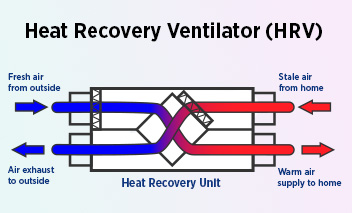The All-Inclusive Overview to the Uses of Heat Recovery Ventilation in Modern Buildings
Heat Recovery Ventilation (HRV) systems stand for a considerable advancement in building technology (HRV Heat Recovery Ventilation). They give a technique for exchanging stale interior air with fresh outside air while minimizing power loss. This technique not just improves interior air high quality yet likewise adds to power efficiency in both property and commercial buildings. Recognizing the various applications and benefits of HRV can disclose its vital duty in contemporary layout and sustainability efforts. The implications of this modern technology are worth exploring better
Understanding Heat Recovery Ventilation Equipments

Although numerous modern-day buildings focus on energy effectiveness, recognizing heat healing air flow (HRV) systems is essential for enhancing interior air quality and minimizing power consumption. HRV systems work by transferring warmth from stale interior air to inbound fresh air, successfully preserving comfortable interior temperature levels while minimizing energy loss. These systems are composed of a warmth exchanger, followers, and ductwork that promote the blood circulation of air. Throughout winter months, HRV devices record and recycle heat from the outward bound air, while in summer, they can assist cool incoming air. By continuously exchanging air, HRV systems additionally lower moisture and the focus of interior pollutants. Appropriate installation and maintenance of HRV systems are necessary for their effectiveness and efficiency in improving overall building efficiency and convenience.
Benefits of Heat Recovery Ventilation
Heat recovery ventilation systems offer numerous advantages that boost both energy efficiency and interior air top quality in contemporary buildings. By recording and recycling energy from exhaust air, these systems significantly lower home heating and air conditioning expenses, leading to reduced energy consumption. They keep a stable circulation of fresh outside air, decreasing the threat of indoor air pollutants and irritants. This continuous exchange assists control humidity degrees, stopping mold and mildew growth and making sure a healthier living setting. Additionally, HRV systems add to sustainability goals by reducing overall carbon footprints. Their capacity to enhance air flow without giving up thermal comfort makes them a beneficial enhancement to modern structure style, promoting both financial and environmental advantages.
Applications of HRV in Residential Buildings
As property owners progressively prioritize power efficiency and indoor air top quality, the applications of warm recuperation ventilation (HRV) systems in household buildings have actually come to be much more common. HRV systems are specifically advantageous in securely secured homes, where maintaining fresh air circulation is essential for protecting against moisture buildup and indoor pollutants. They efficiently transfer warmth from outward bound stale air to incoming fresh air, minimizing power costs associated with heating & cooling. Furthermore, HRVs can boost convenience degrees by regulating humidity and temperature level. They are also adaptable for different property layouts, consisting of single-family homes and multi-unit structures. On the whole, incorporating HRV systems sustains lasting living techniques while ensuring a healthier interior atmosphere for owners.
HRV in Business and Commercial Setups
In commercial and industrial settings, the implementation of warm recuperation air flow (HRV) systems has actually come to be significantly essential for optimizing energy performance and keeping air top quality. These systems successfully transfer heat from exhaust air to incoming fresh air, lowering the demand for extra heating or cooling. This not just decreases power expenses however also adds to sustainability campaigns. Industries such as manufacturing, warehousing, and office structures benefit significantly from HRV systems, as they aid manage temperature and humidity degrees, guaranteeing a comfortable and effective atmosphere. Additionally, HRV systems help in getting rid of pollutants and excess moisture, boosting interior air quality. As laws around air quality come to be stricter, the fostering of HRV innovation is most likely to expand, making it an essential part of modern-day industrial and industrial infrastructure.
Future Fads in Heat Recovery Ventilation Innovation

Regularly Asked Questions
How Does Heat Recovery Ventilation Impact Indoor Air Quality?
Heat visit this web-site recovery ventilation considerably enhances interior air quality by continuously exchanging stale indoor air with fresh outside air while recouping energy. This process decreases pollutants, maintains ideal moisture degrees, and ensures a healthier environment for owners.
Can HRV Systems Be Mounted in Existing Structures?
HRV systems can undoubtedly be mounted in existing structures. Retrofitting may call for alterations to ductwork and ventilation layouts, yet it significantly enhances energy performance and indoor air quality, making it a sensible choice for older structures.
What Upkeep Is Required for HRV Systems?

Exist Certain Climates Where HRV Is Much More Effective?
Heat recovery ventilation systems are specifically efficient in climates with substantial temperature distinctions between seasons. These systems optimize energy effectiveness by recovering warm from exhaust air, making them ideal for both cool and reasonably warm atmospheres.
How Do HRV Systems Affect Power Expenses?
